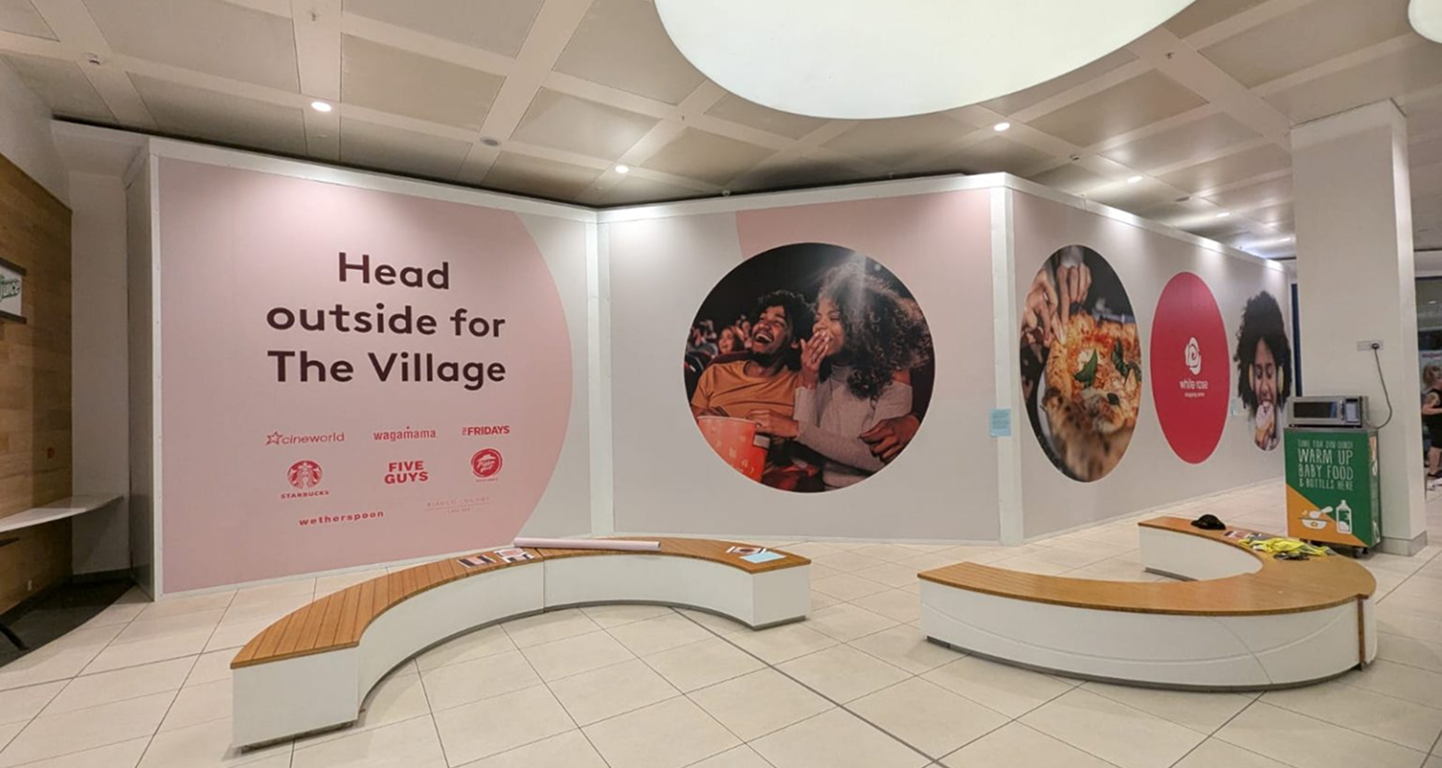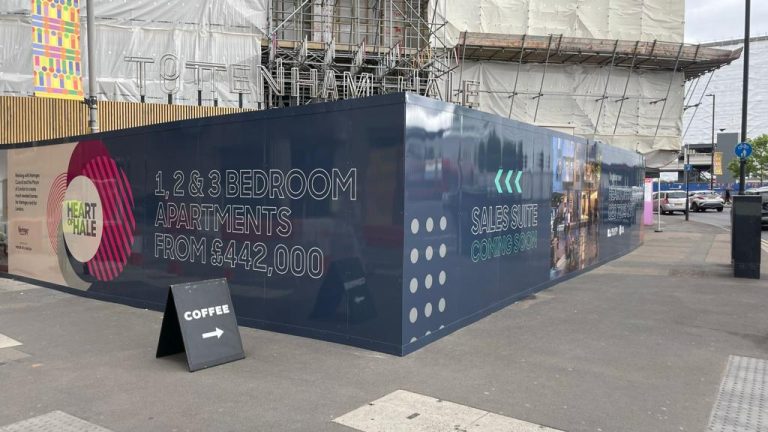
Environmental Graphics Signage inspires, stimulates, and transforms spaces and surfaces, clearly defining the vision and culture of your workplace. Whether it’s walls, windows, ceilings, floors, or even elevators, Environmental Graphics Signage creates a seamless and immersive experience for employees, visitors, and customers. The precision in printing and creativity enhance your brand visibility and reputation that reflect your brand’s identity.
ARC’s experience and expertise enable us to deliver an unsurpassed standard of excellence in Environmental Graphics Printing, ensuring your graphics are printed and installed with absolute precision, care, and attention to detail. Count on us to create stunning visualisations, as our design team masters in imagining ideas and bringing them to life!
Environmental graphics change how people feel in a space. They influence behaviour, improve navigation and make brand values visible. They also create an impactful first impression for visitors and staff.
Environmental graphics use colour, typography, imagery and materials to bring environments to life. They connect architecture with brand storytelling. This helps people understand where they are and what the organisation stands for.
Our Offerings Include:
Branded walls, windows and floors become communication tools. This supports the marketing team and facilities managers who need spaces to work harder without major fit out costs.

From concept to installation, ARC UK handles every stage of your environmental graphics project. Our in-house design team conceives innovative visuals that align with your brand identity. We then move to print and manufacture in our UK facilities, before our expert installation teams deliver and apply the graphics precisely. This complete workflow - design, print, manufacture, plus nationwide installation, ensures that your vision is realised with consistency and care.
Our designers are skilled in spatial storytelling: whether you want a motivational mural in an office, a branded retail environment, or wayfinding graphics in a hospital, we create visual narratives that connect emotionally and practically with people. We also use high-tech document imaging to visualise how designs will look in real spaces, so you can be confident in the concept before production.
We leverage ARC UK’s advanced wide-format digital printing capabilities to deliver crisp, vivid, large-scale graphics across a variety of substrates. Whether it's vinyl for windows, adhesive film for walls, or specialist floor graphics, our print quality is second to none. We also prioritise sustainability: ARC UK is ISO 14001-certified, underlining our commitment to eco-friendly processes and materials.
Environmental graphics from ARC UK are designed to last. We use robust materials and coatings that stand up to wear and foot traffic, while maintaining visual brilliance. Whether it’s a busy public space or a high-traffic stairwell, our graphics are made to perform.
Thanks to our network of production and service centres across the UK, including strategic hubs in Dartford, Bridgwater, Manchester, Leeds, Birmingham, and Scotland, our installation teams can deliver and install your graphics anywhere, ensuring a seamless finish no matter how geographically spread your project is. Our project managers coordinate every step, ensuring that the installation is efficient, on time, and aligned with your operational needs.
ARC UK holds ISO 9001 certification for quality management in printing and signage. ARC UK This means you can trust that your graphics will be delivered and installed to the highest standards, with full accountability.
ARC UK is part of the global ARC family, with 140+ facilities supporting over 65,000 customers across 10,200 locations worldwide. We deliver world-class products and services backed by leading independent certifications, constantly elevating our standards to ensure exceptional quality, a safe and secure workplace, and a reduced environmental impact.

Review Date
Full Text
ARC UK delivers a complete environmental graphics design and printing services – from conception, design to installation. In short, you will get everything from one single platform.
Our environmental graphics printing service includes:
You can supply artwork or brief our design team. Both options are common in B2B projects. We are comfortable working with agencies, contractors and clients.

Strong results come from effective planning. Every project begins with understanding the environment, audience and purpose.
We consider:
Environmental graphic design is not just about decorating a place. It shapes experience and establishes communication. Our designers and production teams work closely with our clients, transforming their imagination into reality.

Choosing the right material ensures longevity and safety. ARC UK offers a wide range of material choices so that each application perfectly fits for the purpose.
Options include:
We also supply environmental graphics signage and environmental print solutions for exterior applications where UV stability and weather resistance are essential. Quality control covers colour accuracy, alignment and clean installation. Spaces remain operational wherever possible.

For B2B environments, looks are important but performance is critical. ARC UK follows strict standards so environmental graphics remain safe and effective.
Our approach includes:
This protects investment and ensures long term performance. Many corporate clients rely on us because of our consistency and effective planning across locations.

ARC UK has delivered environmental graphics projects for large organisations, public bodies and private companies. Projects have included full office branding schemes, campus wayfinding and experiential retail spaces.
Corporate & Commercial Offices
Elevate your workspace with branded wall murals, wayfinding systems, and motivational graphics — creating an inspiring, cohesive environment that reinforces your corporate identity.
Retail & Hospitality
Transform shop interiors, hotel lobbies, and restaurant spaces into immersive brand experiences. Floor graphics can guide customers, while window graphics and wall wraps bring vibrancy and story.
Healthcare & Education
Use environmental graphics to improve wayfinding, make clinics or campuses feel more welcoming, and communicate important messages in an engaging and visually consistent way.
Public & Transport Spaces
Airports, train stations, and public buildings benefit from expertly designed graphics that inform, direct, and enhance ambience. Our graphics help in navigating complex environments comfortably and efficiently.
Event Venues & Exhibitions
Build immersive, branded environments for exhibitions, trade shows, and conferences. Graphic-rich spaces attract attention and leave a memorable impact on attendees.

Environmental graphics printing is the design and production of large visual elements that enhance buildings and spaces. This includes wall murals, wayfinding, window films and branded features. It connects graphic design with interiors and architecture to shape how spaces are experienced.
Environmental graphic design is the practice of using graphics in physical spaces to guide, inform and engage people. It blends branding, signage and interiors. This means environments both look better and function better.
It is used by businesses, public sector organisations, education providers and venues. It is suitable for offices, campuses, hospitals and retail environments. Marketing and facilities teams often commission it.
Benefits include improved brand expression, better navigation, stronger employee engagement and visually unified spaces. It can refresh environments without full refurbishment and often at lower cost.
Most projects install within one to three days depending on scale. Larger campus projects may be phased. This means disruption to daily operations is kept minimal.
Common materials include vinyl films, wall coverings, acrylic panels and laminates. Material selection depends on surface type, durability needs and fire compliance. We provide advice and samples.
Yes. Removable systems mean spaces can be branded without permanent alteration. This is popular with serviced offices and leasehold environments.
Yes. Environmental signage supports clear movement through complex sites like hospitals and universities. It reduces confusion and improves visitor confidence.
Yes. Sustainable media and reduced VOC inks are available for environmental printing. This supports corporate sustainability policies while maintaining quality.
Costs depend on scale, materials and installation complexity. Small projects may start in the hundreds of pounds. Large branded environments are priced following a survey and design review.
Yes. National coverage and central project management allow consistent delivery across many locations. This benefits national brands and estate portfolios.
Yes. Our team provides environmental graphic design services or works with your agency. You can choose either route. This flexibility suits both marketing managers and contractors.
Yes – ARC’s design team can create stunning visualisations to help you envision how environmental graphics will transform your space.
ARC delivers top-tier quality with precision in both print and installation – ensuring environmental graphics are executed with meticulous care and attention to detail.
Simply submit an enquiry via ARC’s website to initiate your consultation – discuss your space, design goals, and get started with visual planning and production.
If you’re looking to reimagine your environment – whether an office, retail outlet, education space, or public venue, ARC UK is your trusted partner. Contact us today via our ARC UK or reach out to one of our UK centres in Dartford or Bridgwater to explore how our environmental graphics design and printing service can bring your vision to life.